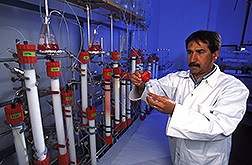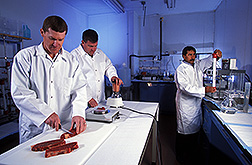Working Towards a Consistently Tender Steak
Imagine enjoying a delicious, tender steak at the finest restaurant in the region. Now, imagine eating an equally tender steak at the greasy old diner around the corner. In the future, that may happen thanks to work by Agricultural Research Service (ARS) scientists to make steaks consistently tender.
"Tenderness is the most important trait to consumers," animal physiologist Mohammad Koohmaraie explains, "and the most variable."
Koohmaraie leads a group of scientists at the ARS Roman L. Hruska U.S. Meat Animal Research Center (MARC) in researching biochemical mechanisms that make the meat of certain cattle tender and then trying to breed bulls that should sire guaranteed-tender offspring.
The MARC group started making some significant discoveries in the mid 1980s at the Clay Center, Nebraska, laboratory. Koohmaraie and food technologist Tommy L. Wheeler found that the tenderness of meat changes during postmortem aging—first going through a toughening phase before the tenderization phase begins.
Right after slaughter, meat is tender. But for the next 12 hours or so, rigor mortis takes place, stiffening the muscles and making the meat tough. Toward the end of the toughening phase, while the carcass is hanging in a cooler, the tenderization phase begins, which makes most meat—but not all—suitably tender.
The researchers found that tenderization was caused by the enzyme µ-calpain degrading some muscle proteins. They believe industry shouldn't sell meat before it has aged for 14 days, because the postmortem research found that before that time, steaks are more likely to be tough. But those extra days add considerable cost to production because of the requirements for space and controlled temperature.
 |
| Physiologist Mohammad Koohmaraie loads a muscle extract onto an ion-exchange chromatography column to isolate calpain and calpastatin. (K11704-1) |
Koohmaraie explains that not all meat reaches the same level of tenderization. His group wanted to find out why some meats become more tender while others stay too tough. First, through protein chemistry and electron microscopy, they found that µ-calpain breaks down muscle proteins, making meat tender. Because the calpain enzyme requires calcium for this activity, Koohmaraie and Wheeler developed a way of injecting calcium into meat to help the tenderization process along. This marination technique could be used to produce meat that has both improved tenderness and juiciness.
Doing more research, Koohmaraie and food technologist Steven D. Shackelford found that although µ-calpain causes the protein degradation that improves tenderness, it's actually the activity of a protein called calpastatin that determines how much calpain is active—and thus how tender the steak will be. "The most significant part of this project was learning that it's calpastatin—not calpain—which controls tenderness," Koohmaraie says.
Since that discovery, other ARS and non-ARS laboratories have confirmed that the calpastatin system indeed greatly influences how tender steaks are. But attempts to develop a tenderness classification system based on calpastatin activity have not been successful. This is because calpastatin explains just 45 percent of the variation in tenderness, which is not high enough for accurate classification.
Koohmaraie's collaborators at MARC, chemist Timothy P.L. Smith and geneticist Eduardo Casas, have taken a complementary genetic approach to studying the µ-calpain system. They used a large population of crossbred cattle to identify genes influencing tenderness. They found that variation in the gene that produces µ-calpain appears to affect tenderization.
"We're using genetics to identify DNA markers that can track variation in the calpain gene," Smith says, "and we're looking for DNA tests that can predict the likelihood that a given animal will produce tender meat." This will permit breeding cattle that ranchers will know are more likely to produce consistently tender offspring.
The researchers have made some progress. By sequencing the gene that produces µ-calpain in both tender and tough cattle, Smith and Casas identified differences that can be used as DNA markers. They have released a DNA test that was effective in identifying tough animals among a large herd of beef cattle representing the most popular beef breeds in the United States. The researchers continue to develop additional markers for use in other breeds.
And since research indicates that there may be many genes other than µ-calpain and calpastatin that influence tenderness—each having a relatively small effect—Smith and Casas warn that more genetic markers will be required to explain enough of the variation to accurately guide breeding choices.
Koohmaraie and Smith stress that tenderness is only about half due to genetics of the animal; the rest is the result of nongenetic, environmental factors such as stress or diet. "There is only so much we can do with genetics," Smith says. The rest is determined by how the animal and the meat are handled throughout the various steps of beef production.
About 10 years ago, Koohmaraie, Shackelford, and Wheeler developed a tenderness classification system that determines the quality from individual animals. It's been used by some beef processors and retailers to market a guaranteed-tender product line. An updated system is expected soon.—By David Elstein, Agricultural Research Service Information Staff.
This research is part of Food Animal Production, an ARS National Program (#101) described on the World Wide Web at www.nps.ars.usda.gov.
Mohammad Koohmaraie, Timothy P.L. Smith, Steven D. Shackelford, Tommy L. Wheeler, and Eduardo Casas are with the USDA-ARS Roman L. Hruska U.S. Meat Animal Research Center, Spur 18D, Clay Center, NE 68933; phone (402) 762-4100, fax (402) 762-4149.
"Working Towards a Consistently Tender Steak" was published in the February 2005 issue of Agricultural Research magazine.







